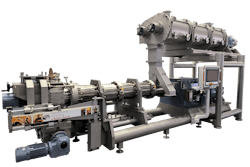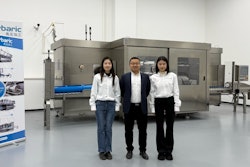
High-pressure thermal processing (HPTP), an emerging technology derived from high-pressure processing (HPP), is an effective way to ensure product safety while maintaining nutritional integrity and clean labels.
HPTP aims to create microbially safe products that can be shelf stable, fresh or minimally cooked. HPTP involves preheating packaged products and then applying high pressure to effectively raise the temperature. This process inactivates spore-forming bacteria at 250 degrees Fahrenheit in shorter timeframes, helping develop chilled, stable minimally cooked products with an extended shelf life and that maintain high added value while reducing thermal load.
Since the 2011 update to the Food Safety Modernization Act (FSMA), pet food processors have been required to implement interventions to control pertinent pathogens. The U.S. Food and Drug Administration (FDA) specifically requires a five-log reduction of concern pathogens including Salmonella, Listeria, E. coli and Clostridium botulinum in shelf-stable products.
“FDA will be asking (pet food manufacturers) to implement these lethal interventions in order to control these pathogens,” said Daniela Soto, HPP food specialist at Hiperbaric, who spoke during Petfood Forum 2025 in Kansas City, Missouri, U.S.
Traditional processing limitations
Conventional thermal processing methods such as retort have long been the industry standard for creating shelf-stable pet food products. While effective at creating shelf-stable products with clean labels, retort processing has some drawbacks.
“Retort has some limitations, such as the high thermal load that is implemented in the process because of the time duration that it has,” Soto said.
Non-thermal technologies also present their own challenges. UV treatment is only effective on surface areas, bacteriophage application struggles to achieve sufficient reduction levels and fermentation alters smell and taste profiles while offering limited pathogen control. HPP provides effective pathogen reduction but requires refrigeration and can cause color changes in raw meat products.
HPTP: A new solution
HPTP represents a technological breakthrough that combines the benefits of high pressure with controlled thermal treatment.
“With this technology, while combining high pressure and high temperature, we’ll be able to achieve a sterilization faster than retort because of the high pressures used,” Soto said. “And also we’ll be able to create shelf-stable products, as we’ll be targeting spore formers … and we’ll be minimizing that thermal load as well as reducing that processing time.”
HPTP works by preheating food products in specialized canisters, then subjecting them to high pressure (up to 6,000 bars) while maintaining elevated temperatures. This combination allows processors to reach sterilization temperatures of 250 degrees Fahrenheit under pressure in much less time than traditional retort processing.
Pet food manufacturers can implement HPTP in two ways: by processing raw formulas to create frozen or refrigerated products which can then be freeze-dried to create shelf stable products, or as a post-lethality treatment to achieve a two- or three-log reduction in cooked products post-packaging to prevent any recontamination.
Key benefits for pet food manufacturers
HPTP offers several advantages that make it particularly appealing for premium pet food production:
- Reduced processing time: HPTP significantly shortens the time required to reach sterilization temperatures compared with retort processing.
- Uniform heating: Due to the isostatic principle, everything within the processing vessel experiences the same pressure and temperature simultaneously, eliminating thermal gradients.
- Nutrient preservation: Studies show HPTP better preserves bioactive compounds such as carotenoids compared with retort processing.
- Color retention: The reduced thermal load helps maintain vibrant natural colors in ingredients.
- Fewer processing contaminants: HPTP produces significantly fewer furans and other processing contaminants than conventional retort processing.

















